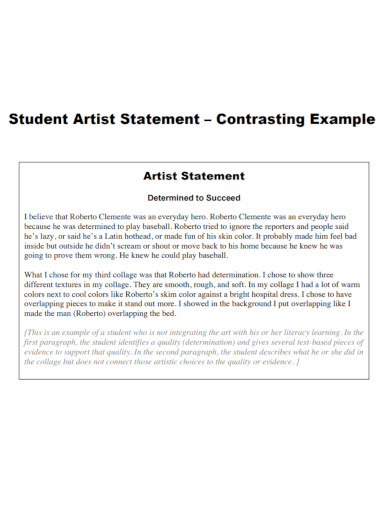If you want opportunities that will help your artist career be successful, consider writing an artist statement. It does not only speak about yourself but it also speaks on behalf of your individual artworks. Most portfolios need artist statements to provide information about the artist and his or her artworks for the benefit of art buyers and artwork reviewers. Every artist has the freedom to express his or her thoughts, thus providing a more intense understanding of the artwork.
[bb_toc content=”][/bb_toc]
4+ Student Artist Statement Examples
1. Student Artist Learning Statement
2. Student Artist Statement Template
3. Student Artist Statement Example
4. Student Application Artist Statement
5. Student Artist Learning Originality
What is an Artist Statement?
An artist statement provides an overview of your work or project. It does not require long explanations, anecdotes, jargons, technical words or even prose writing. It should be written in first person and contains three paragraphs only.
The first paragraph should contain basic ideas about your artwork and does not exceed three sentences. The second paragraph should contain the details of an issue that is present in your artwork. You are going to provide an explanation about the issue and you can even relate that certain issue to what is currently happening around us right now. You may consider following this guide.
– Include the reason why you created such piece
– What could be your audience’s reaction to it?
– Are there any relations between your previous and current artwork?
– Does your artwork fit the current art styles?
– Will your artwork fit in the theme of an art exhibition?
– What is your inspiration in making the artwork?
– What technique did you use?
– Does your technique play an important role for the success of your artwork?
The last paragraph is your conclusion. This contains the summary of your statement.
Here are some short statements from famous artists:
- “I was walking along a path with two friends – the sun was setting – suddenly the sky turned blood red – I paused, feeling exhausted, and leaned on the fence – there were blood and tongues of fire above the blue-black fjord and the city – my friends walked on, and I stood there trembling with anxiety – and I sensed an infinite scream passing through nature.”
Edward Munch, The Scream (1893)
- “The pre-homoeroticized body forms both my field of action and the basis of my conceptual taxonomy. My sculptures explore both the flux of transfixable signifiers and their complimentary anecdotal formations. My choice of Carrara marble as a medium creates a dialectic between proto-Classical conceptions of idealized form and later Humanistic naturalism. Each figure’s physical struggle is simultaneously inoperative and adjectival.”
Michaelangelo Buonarroti, The Rebellious Slave (1513)
- “I’ve drawn my whole life. My parents were in the tapestry restoration business, and as a young girl, I would draw in the missing parts of the tapestry that needed to be re-woven. My ability to draw made me indispensable to my parents. I came from a family of repairers. The spider is a repairer. If you bash into the web of a spider, she doesn’t get mad. She weaves and repairs it. ‘The Spider’ is an ode to my mother. She was my best friend. Like a spider, my mother was a weaver. . . Like spiders, my mother was very clever. Spiders are friendly presences that eat mosquitoes. So, spiders are helpful and protective, just like my mother.”
Louise Bourgeois, Spider (1996)
artdex.com
Steps on How to Write an Artist Statement
- Secure an artist journal that contains your goals, the process, materials, thoughts, influences, strength and weaknesses.
- Be inspired from reading other artist’s statements. You may do so by reading online, galleries and more.
- The length of your statement differs from where are you going to place your artwork. There are guidelines that you must follow. Preferably, you will be required to write only a limited number of words. Keep it concise.
- Write a draft of your statement.
- Make necessary corrections on your draft until you are able to finalize your statement.
In what point of view are you going to use in writing an artist statement?
Artist statements are usually written in first person.
How long is an artist statement?
It should contain more or less 300 words.
How do you start an artist statement?
Start with a sentence that is straight to the point and can easily grab the attention of the readers.
Writing an artist statement is fun. You were able to tell people about your amazing artwork and at the same time allows them to know what inspires you in making such. Your artist statement will be able to represent you even while you are not there.








